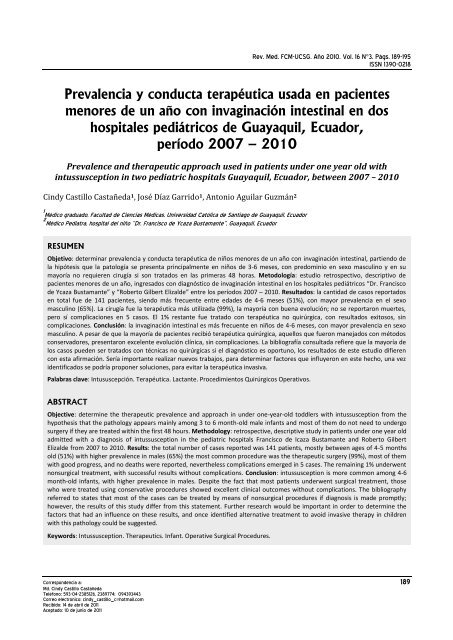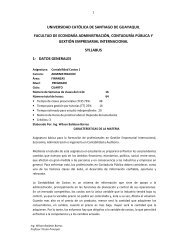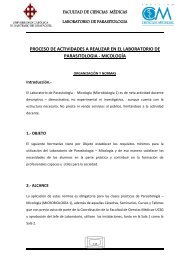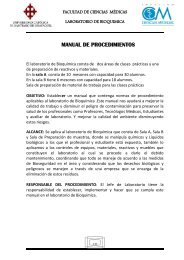el simbolismo médico: la lucha eterna - 201 - Universidad Católica ...
el simbolismo médico: la lucha eterna - 201 - Universidad Católica ...
el simbolismo médico: la lucha eterna - 201 - Universidad Católica ...
Create successful ePaper yourself
Turn your PDF publications into a flip-book with our unique Google optimized e-Paper software.
Rev. Med. FCM-UCSG. Año <strong>201</strong>0. Vol. 16 N°3. Págs. 189-195<br />
ISSN 1390-0218<br />
Prevalencia y conducta terapéutica usada en pacientes<br />
menores de un año con invaginación intestinal en dos<br />
hospitales pediátricos de Guayaquil, Ecuador,<br />
período 2007 – <strong>201</strong>0<br />
Prevalence and therapeutic approach used in patients under one year old with<br />
intussusception in two pediatric hospitals Guayaquil, Ecuador, between 2007 – <strong>201</strong>0<br />
Cindy Castillo Castañeda 1, José Díaz Garrido 1, Antonio Agui<strong>la</strong>r Guzmán 2<br />
1 Médico graduado, Facultad de Ciencias Médicas, <strong>Universidad</strong> <strong>Católica</strong> de Santiago de Guayaquil, Ecuador<br />
2 Médico Pediatra, hospital d<strong>el</strong> niño “Dr. Francisco de Ycaza Bustamante”, Guayaquil, Ecuador<br />
RESUMEN<br />
Objetivo: determinar prevalencia y conducta terapéutica de niños menores de un año con invaginación intestinal, partiendo de<br />
<strong>la</strong> hipótesis que <strong>la</strong> patología se presenta principalmente en niños de 3-6 meses, con predominio en sexo masculino y en su<br />
mayoría no requieren cirugía si son tratados en <strong>la</strong>s primeras 48 horas. Metodología: estudio retrospectivo, descriptivo de<br />
pacientes menores de un año, ingresados con diagnóstico de invaginación intestinal en los hospitales pediátricos “Dr. Francisco<br />
de Ycaza Bustamante” y “Roberto Gilbert Elizalde” entre los períodos 2007 – <strong>201</strong>0. Resultados: <strong>la</strong> cantidad de casos reportados<br />
en total fue de 141 pacientes, siendo más frecuente entre edades de 4-6 meses (51%), con mayor prevalencia en <strong>el</strong> sexo<br />
masculino (65%). La cirugía fue <strong>la</strong> terapéutica más utilizada (99%), <strong>la</strong> mayoría con buena evolución; no se reportaron muertes,<br />
pero sí complicaciones en 5 casos. El 1% restante fue tratado con terapéutica no quirúrgica, con resultados exitosos, sin<br />
complicaciones. Conclusión: <strong>la</strong> invaginación intestinal es más frecuente en niños de 4-6 meses, con mayor prevalencia en sexo<br />
masculino. A pesar de que <strong>la</strong> mayoría de pacientes recibió terapéutica quirúrgica, aqu<strong>el</strong>los que fueron manejados con métodos<br />
conservadores, presentaron exc<strong>el</strong>ente evolución clínica, sin complicaciones. La bibliografía consultada refiere que <strong>la</strong> mayoría de<br />
los casos pueden ser tratados con técnicas no quirúrgicas si <strong>el</strong> diagnóstico es oportuno, los resultados de este estudio difieren<br />
con esta afirmación. Sería importante realizar nuevos trabajos, para determinar factores que influyeron en este hecho, una vez<br />
identificados se podría proponer soluciones, para evitar <strong>la</strong> terapéutica invasiva.<br />
Pa<strong>la</strong>bras c<strong>la</strong>ve: Intususcepción. Terapéutica. Lactante. Procedimientos Quirúrgicos Operativos.<br />
ABSTRACT<br />
Objective: determine the therapeutic prevalence and approach in under one-year-old toddlers with intussusception from the<br />
hypothesis that the pathology appears mainly among 3 to 6 month-old male infants and most of them do not need to undergo<br />
surgery if they are treated within the first 48 hours. Methodology: retrospective, descriptive study in patients under one year old<br />
admitted with a diagnosis of intussusception in the pediatric hospitals Francisco de Icaza Bustamante and Roberto Gilbert<br />
Elizalde from 2007 to <strong>201</strong>0. Results: the total number of cases reported was 141 patients, mostly between ages of 4-5 months<br />
old (51%) with higher prevalence in males (65%) the most common procedure was the therapeutic surgery (99%), most of them<br />
with good progress, and no deaths were reported, neverth<strong>el</strong>ess complications emerged in 5 cases. The remaining 1% underwent<br />
nonsurgical treatment, with successful results without complications. Conclusion: intussusception is more common among 4-6<br />
month-old infants, with higher prevalence in males. Despite the fact that most patients underwent surgical treatment, those<br />
who were treated using conservative procedures showed exc<strong>el</strong>lent clinical outcomes without complications. The bibliography<br />
referred to states that most of the cases can be treated by means of nonsurgical procedures if diagnosis is made promptly;<br />
however, the results of this study differ from this statement. Further research would be important in order to determine the<br />
factors that had an influence on these results, and once identified alternative treatment to avoid invasive therapy in children<br />
with this pathology could be suggested.<br />
Keywords: Intussusception. Therapeutics. Infant. Operative Surgical Procedures.<br />
Correspondencia a: 189<br />
Md. Cindy Castillo Castañeda<br />
T<strong>el</strong>éfono: 593-04-2385126, 2389774; 094393443<br />
Correo <strong>el</strong>ectrónico: cindy_castillo_c@hotmail.com<br />
Recibido: 14 de abril de <strong>201</strong>1<br />
Aceptado: 10 de junio de <strong>201</strong>1





